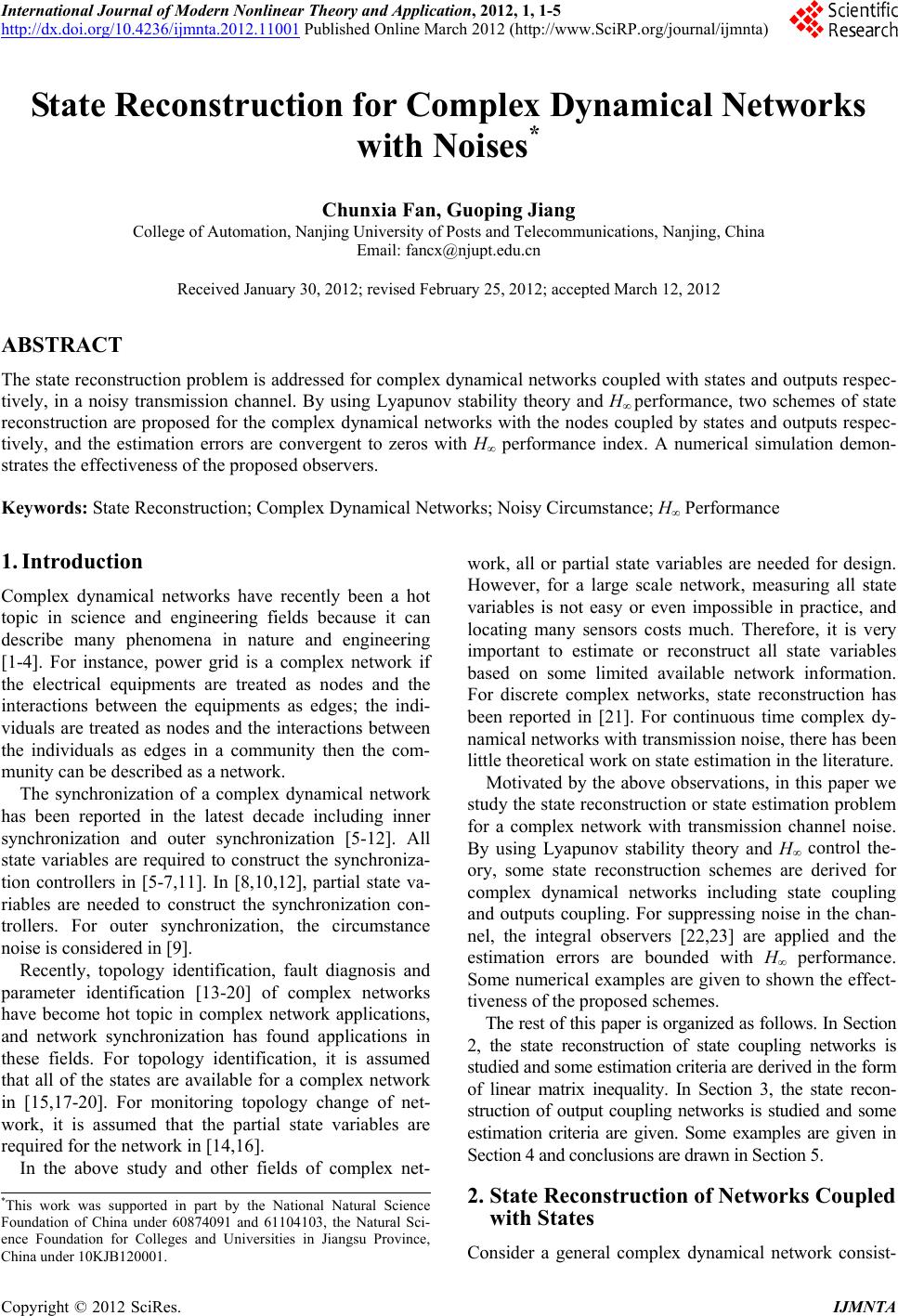 International Journal of Modern Nonlinear Theory and Application, 2012, 1, 1-5 http://dx.doi.org/10.4236/ijmnta.2012.11001 Published Online March 2012 (http://www.SciRP.org/journal/ijmnta) State Reconstruction for Complex Dynamical Networks with Noises* Chunxia Fan, Guoping Jiang College of Automation, Nanjing University of Posts and Telecommunications, Nanjing, China Email: fancx@njupt.edu.cn Received January 30, 2012; revised February 25, 2012; accepted March 12, 2012 ABSTRACT The state reconstruction problem is addressed for complex dynamical networks coupled with states and outputs respec- tively, in a noisy transmission channel. By using Lyapunov stability theory and H∞ performance, two schemes of state reconstruction are proposed for the complex dynamical networks with the nodes coupled by states and outputs respec- tively, and the estimation errors are convergent to zeros with H∞ performance index. A numerical simulation demon- strates the effectiveness of the proposed observers. Keywords: State Reconstruction; Complex Dynamical Networks; Noisy Circumstance; H∞ Performance 1. Introduction Complex dynamical networks have recently been a hot topic in science and engineering fields because it can describe many phenomena in nature and engineering [1-4]. For instance, power grid is a complex network if the electrical equipments are treated as nodes and the interactions between the equipments as edges; the indi- viduals are treated as nodes and the interactions between the individuals as edges in a community then the com- munity can be described as a network. The synchronization of a complex dynamical network has been reported in the latest decade including inner synchronization and outer synchronization [5-12]. All state variables are required to construct the synchroniza- tion controllers in [5-7,11]. In [8,10,12], partial state va- riables are needed to construct the synchronization con- trollers. For outer synchronization, the circumstance noise is considered in [9]. Recently, topology identification, fault diagnosis and parameter identification [13-20] of complex networks have become hot topic in complex network applications, and network synchronization has found applications in these fields. For topology identification, it is assumed that all of the states are available for a complex network in [15,17-20]. For monitoring topology change of net- work, it is assumed that the partial state variables are required for the network in [14,16]. In the above study and other fields of complex net- work, all or partial state variables are needed for design. However, for a large scale network, measuring all state variables is not easy or even impossible in practice, and locating many sensors costs much. Therefore, it is very important to estimate or reconstruct all state variables based on some limited available network information. For discrete complex networks, state reconstruction has been reported in [21]. For continuous time complex dy- namical networks with transmission noise, there has been little theoretical work on state estimation in the literature. Motivated by the above observations, in this paper we study the state reconstruction or state estimation problem for a complex network with transmission channel noise. By using Lyapunov stability theory and H∞ control the- ory, some state reconstruction schemes are derived for complex dynamical networks including state coupling and outputs coupling. For suppressing noise in the chan- nel, the integral observers [22,23] are applied and the estimation errors are bounded with H∞ performance. Some numerical examples are given to shown the effect- tiveness of the proposed schemes. The rest of this paper is organized as follows. In Section 2, the state reconstruction of state coupling networks is studied and some estimation criteria are derived in the form of linear matrix inequality. In Section 3, the state recon- struction of output coupling networks is studied and some estimation criteria are given. Some examples are given in Section 4 and conclusions are drawn in Section 5. 2. State Reconstruction of Networks Coupled with States *This work was supported in part by the National Natural Science Foundation of China under 60874091 and 61104103, the Natural Sci- ence Foundation for Colleges and Universities in Jiangsu Province, China under 10KJB120001. Consider a general complex dynamical network consist- C opyright © 2012 SciRes. IJMNTA 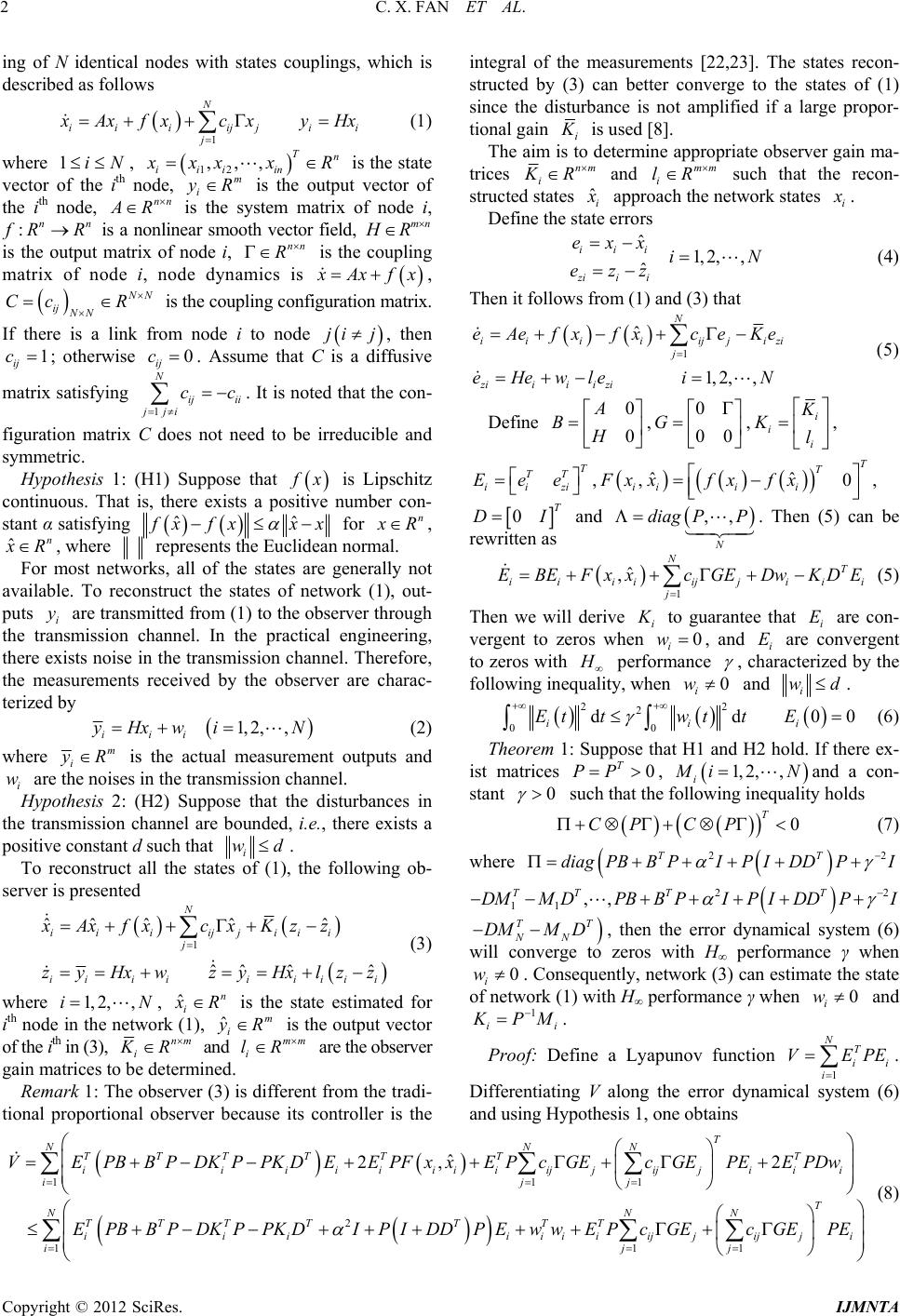 C. X. FAN ET AL. 2 ing of N identical nodes with states couplings, which is described as follows 1 N iiiijj i j i Axf xcxyHx Tn (1) where , ii 1iN 12 ,,, i in xx xR m i is the state vector of the ith node, R nn is the output vector of the ith node, R nn is the system matrix of node i, : RR is a nonlinear smooth vector field, mn R is the output matrix of node i, is the coupling matrix of node i, node dynamics is nn R Axf x , N ij NN Cc R is the coupling configuration matrix. If there is a link from node i to node , then ; otherwise . Assume that C is a diffusive ji j 1 ij c0 ij c N matrix satisfying . It is noted that the con- 1 ij ii jji cc figuration matrix C does not need to be irreducible and symmetric. Hypothesis 1: (H1) Suppose that x is Lipschitz continuous. That is, there exists a positive number con- stant α satisfying ˆˆ xfx xx for n R, ˆn R, where represents the Euclidean normal. For most networks, all of the states are generally not available. To reconstruct the states of network (1), out- puts i are transmitted from (1) to the observer through the transmission channel. In the practical engineering, there exists noise in the transmission channel. Therefore, the measurements received by the observer are charac- terized by y 1, 2,, iii Hx wiN (2) where m i R is the actual measurement outputs and are the noises in the transmission channel. i w Hypothesis 2: (H2) Suppose that the disturbances in the transmission channel are bounded, i.e., there exists a positive constant d such that i wd. To reconstruct all the states of (1), the following ob- server is presented 1 ˆˆˆ ˆˆ ˆˆ ˆ N ii iijjiii j ii iii iiii xAxfx cxKzz zyHxw zyHxlzz ˆ (3) where , 1, 2,,iNˆn i R ˆi is the state estimated for ith node in the network (1), m R is the output vector of the ith in (3), nm i R and are the observer gain matrices to be determined. mm i lR Remark 1: The observer (3) is different from the tradi- ional proportional observer because its controller is the t integral of the measurements [22,23]. The states recon- structed by (3) can better converge to the states of (1) since the disturbance is not amplified if a large propor- tional gain i is used [8]. The aim is to determine appropriate observer gain ma- trices nm i R and such that the recon- structed states mm i lR ˆi approach the network states i . Define the state errors ˆ1, 2,, ˆ iii zii i exxi ezz N (4) Then it follows from (1) and (3) that 1 ˆ 1,2,, N ii iiijji j ziiii zi eAefx fxceKe eHewleiN zi (5) Define 0 0 A BH , , 0 00 G i i i Kl , T TT zi e ii Ee Fx T ,, ˆ ii i xf x ˆ ,0 T T i f x 0DI and . Then (5) can be rewritten as ,, N diag PP N 1 ˆ ,T ii iiijjii j EBEFxx cGEDwKDE i (5) Then we will derive i to guarantee that i are con- vergent to zeros when E 0 i w , and i are convergent to zeros with E performance , characterized by the following inequality, when and 0 i wi wd . 2 2 2 00 dd00 iii Et twttE (6) Theorem 1: Suppose that H1 and H2 hold. If there ex- ist matrices 0 T PP , 1, 2,, i iNand a con- stant 0 such that the following inequality holds 0CP CP T (7) where 22TT diagPBB PIPIDDPI 22 11 ,, TT TT MMDPBBP IPIDDPI TT NN MMD 0 i w , then the error dynamical system (6) will converge to zeros with H∞ performance γ when . Consequently, network (3) can estimate the state of network (1) with H∞ performance γ when 0 i w and 1 ii PM . Proof: Define a Lyapunov function . 1 Differentiating V along the error dynamical system (6) nd using Hypothesis 1, one obtains NT i i VEP i E i i a 111 2 111 ˆ 2, 2 T NNN TTTT TTT iiiiiiiiijjijjii ijj T NNN TTT TTTT iii iiiiijjijj ijj VEPBBPDKPPKDEEPFxxE PcGEcGEPEEPDw EPB BP DKPPKDIPIDDPEwwEPc GEcGEPE (8) Copyright © 2012 SciRes. IJMNTA 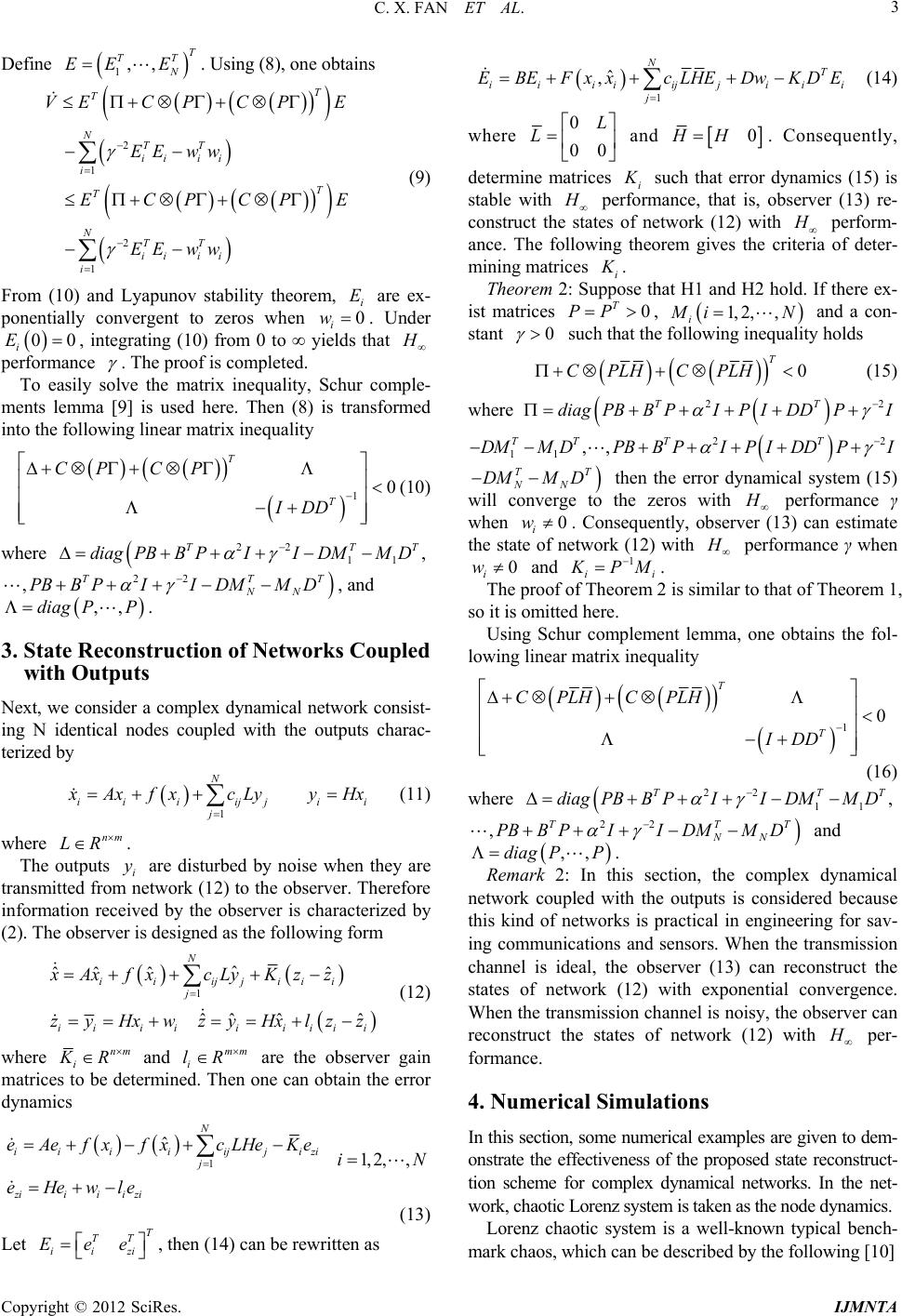 C. X. FAN ET AL. 3 Define . Using (8), one obtains 1,, T TT N EE E T E 2 1 2 1 T NTT ii ii i T T NTT ii ii i VECP CPE EE ww ECPCP EE ww (9) From (10) and Lyapunov stability theorem, are ex- ponentially convergent to zeros when i. Under , integrating (10) from 0 to ∞ yields that i E 0w 00 i E performance . The proof is completed. To easily solve the matrix inequality, Schur comple- ments lemma [9] is used here. Then (8) is transformed into the following linear matrix inequality 10 T T CP CP IDD T (10) where 22 11 , TT diagPBBPIIDMMD 22TTT ,NN PBBPIIDMMD ,,diag PP , and . 3. State Reconstruction of Networks Coupled with Outputs Next, we consider a complex dynamical network consist- ing N identical nodes coupled with the outputs charac- terized by 1 N iiiijj i j i AxfxcLyyHx (11) where . nm LR The outputs i are disturbed by noise when they are transmitted from network (12) to the observer. Therefore information received by the observer is characterized by (2). The observer is designed as the following form y 1 ˆˆˆˆˆ ˆˆ ˆ N ii ijjiii j ii iii iiii xAx fxcLy Kzz zyHxwzyHxlzz ˆ (12) where nm i R and mm i lR are the observer gain matrices to be determined. Then one can obtain the error dynamics 1 ˆ1, 2,, N ii iiijjizi j ziiii zi eAefx fxcLHeKeiN eHewle (13) Let , then (14) can be rewritten as T TT iizi Eee 1 ˆ , NT i ijjiii E cLHEDwKDE iii j BEFxx (14) where 0 00 L L and 0HH. Consequently, atrices determine mi such that error dynamics (15) is stable with peance, that is, observer (13) re- rform f construct the states onetwork (12) with perform- ance. The foing theorem gives the criteria of deter- mining matrices i llow . Theorem 2: Suppose that H1 and H2 hold. If there ex- ist matrices PP 0 T , 1, 2,, i iN and a con- stant 0 such that the following inequality holds 0 T CPLHCPLH (15) where 22TT diagPBBPI PIDDPI 22 1 ,, T TT MDPBBP IPIDDPI 1 T DM TT ) NN DMM D will converge to then the error dynamical system (15 the zeros with performance γ when 0 i w . Consequently, observer (13) can estimate the state of network (12) with performance γ when 0 i w and 1 ii PM . The proof of Theorem 2 is simr to that of Theorem 1, omitted ila so it is here. Using Schur complement lemma, one obtains the fol- lowing linear matrix inequality T CPLHCPLH 10 T ID D (16) where 22 11 , TT diagPBBPIIDMM D 22TTT T and NN B PIIDMMD ,PB ,,diag PP . Remark 2: In this section, the complex dynamical netwed ork couplwith the outputs is considered because this kind of networks is practical in engineering for sav- ing communications and sensors. When the transmission channel is ideal, the observer (13) can reconstruct the states of network (12) with exponential convergence. When the transmission channel is noisy, the observer can reconstruct the states of network (12) with per- formance. 4. Numerical Simulations ples are given to dem- sed state reconstruct- In this section, some numerical exam onstrate the effectiveness of the propo tion scheme for complex dynamical networks. In the net- work, chaotic Lorenz system is taken as the node dynamics. Lorenz chaotic system is a well-known typical bench- mark chaos, which can be described by the following [10] Copyright © 2012 SciRes. IJMNTA 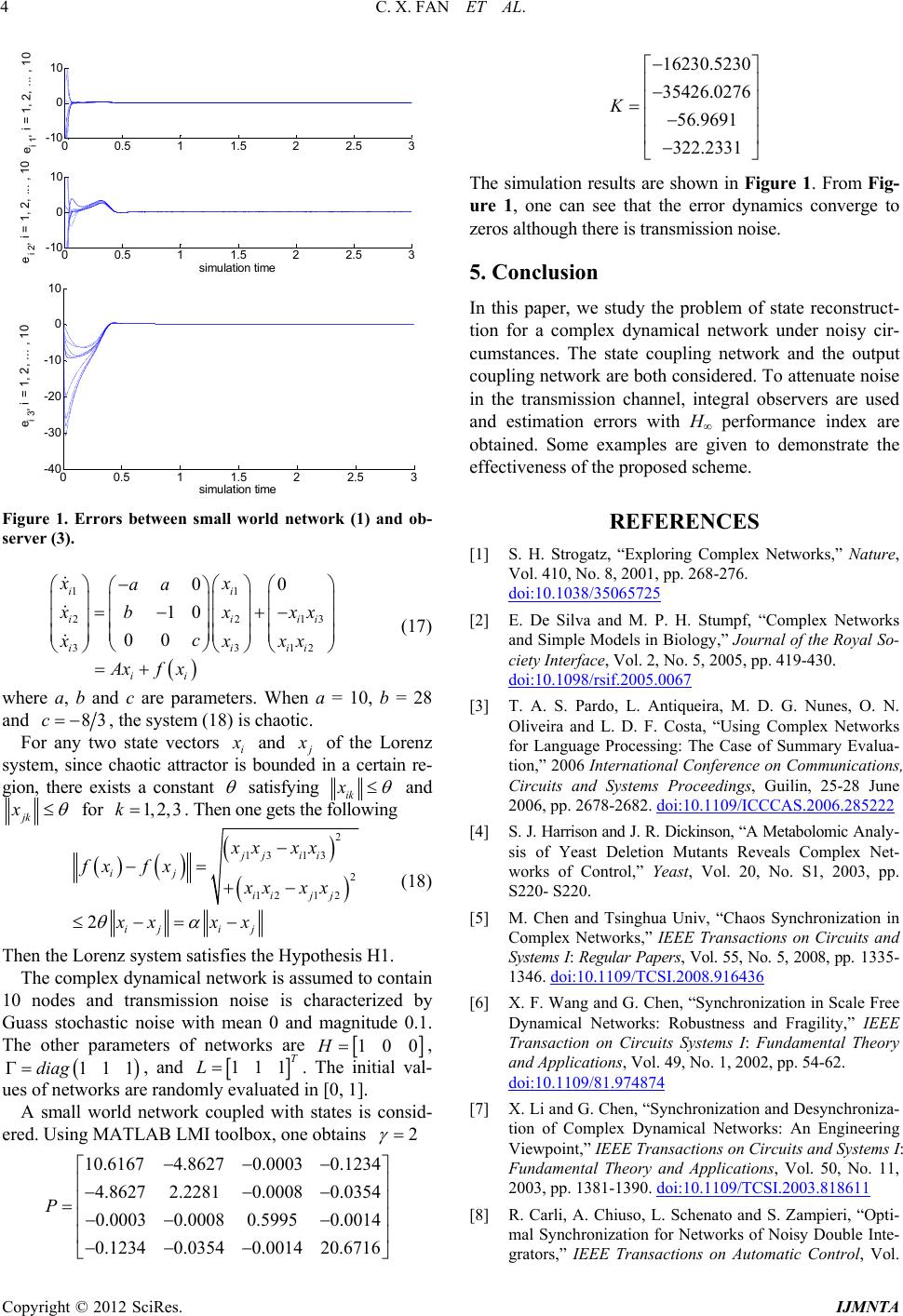 C. X. FAN ET AL. 4 00.5 11.5 22.5 3 -10 0 10 e i 1 , i = 1, 2, ... , 10 00.5 11.5 22.5 3 -10 0 10 simulation time e i 2 , i = 1, 2, ... , 10 00.5 11.522.5 3 -40 -30 -20 -10 0 10 simulation time e i 3 , i = 1, 2, ... , 10 Figure 1. Errors between small world network (1) and ob- server (3). 13 12 ii ii xx (17) where a, b and c are parameters. When a = 10, b = 28 and 1i x 1 22 33 00 10 00 i ii ii ii x aa xbx xx c xx Axf x 83c, the system (18) is chaotic. For any two state vectors i and of the Lorenz syste chaotic attractor is bounded m, since in a certain re- gion, there exists a constant satisfyi ngik x and jk x for 1, 2, 3k. Then one gets the following 2 2 1212 2 ij ii j j ij ij fx xxx x xx xx (18) Then the Lorenz system satisfies the Hypothesis H1. The complex dynamical network is assumed to contain by G 13 13jj ii xx xx fx 10 nodes and transmission noise is characterized uass stochastic noise with mean 0 and magnitude 0.1. The other parameters of networks are 100H, 111diag , and 111 T L. The initial val- ues of networks are randomly evaluated in network c states is consid- ered. Using MATLAB LMI toolbox, one obtains [0, 1]. A small world oupled with 2 10.61674.86270.0003 0.1234 4.8627 2.22810.00080.0354 0.00030.0008 0.59950.0014 0.12340.03540.0014 20.6716 P 16230.5230 35426.0276 56.9691 322.2331 K The simulation results are shown in Figure 1. From Fig- ure 1, one can see that the error dynamics converge to zeros although there is transmission noise. 5. Conclusion nd the output re both considered. To attenuate noise channel, integral observers are used In this paper, we study the problem of state reconstruct- tion for a complex dynamical network under noisy cir- cumstances. The state coupling network a coupling network a in the transmission and estimation errors with H∞ performance index are obtained. Some examples are given to demonstrate the effectiveness of the proposed scheme. REFERENCES [1] S. H. Strogatz, “Exploring Complex Networks,” Nature, Vol. 410, No. 8, 2001, pp. 268-276. doi:10.1038/35065725 [2] E. De Silva aomplex Networks and Simple Mal of the Royal So- nd M. P. H. Stumpf, “C odels in Biology,” Journ ciety Interface, Vol. 2, No. 5, 2005, pp. 419-430. doi:10.1098/rsif.2005.0067 [3] T. A. S. Pardo, L. Antiqueira, M. D. G. Nunes, O. N. , Oliveira and L. D. F. Costa, “Using Complex Networks for Language Processing: The Case of Summary Evalua- tion,” 2006 International Conference on Communications Circuits and Systems Proceedings, Guilin, 25-28 June 2006, pp. 2678-2682. doi:10.1109/ICCCAS.2006.285222 [4] S. J. Harrison and J. R. Dickinson, “A Metabolomic Analy- sis of Yeast Deletion Mutants Reveals Complex Net- works of Control,” Yeast, Vol. 20, No. S1, 2003, pp. S220- S220. [5] M. Chen and Tsinghua Univ, “Chaos Synchronization in Complex Networks,” IEEE Transactions on Circuits and Systems I: Regular Papers, Vol. 55, No. 5, 2008, pp. 1335- 1346. doi:10.1109/TCSI.2008.916436 [6] X. F. Wang and G. Chen, “Synchronization in Scale Free Dynamical Networks: Robustness and Fragility,” IEEE Transaction on Circuits Systems I: Fundamental Theory and Applications, Vol. 49, No. 1, 2002, pp. 54-62. doi:10.1109/81.974874 [7] X. Li and G. Chen, “Synchronization and Desynchroniza- tion of Complex Dynamical Networks: An Engineering Viewpoint,” IEEE Transactions on Circuits and Systems I: Fundamental Theory and Applications, Vol. 50, No. 11, 2003, pp. 1381-1390. doi:10.1109/TCSI.2003.818611 [8] R. Carli, A. Chiuso, L. Schenato and S. Zampieri, “Opti- mal Synchronization for Networks of Noisy Double Inte- grators,” IEEE Transactions on Automatic Control, Vol. Copyright © 2012 SciRes. IJMNTA 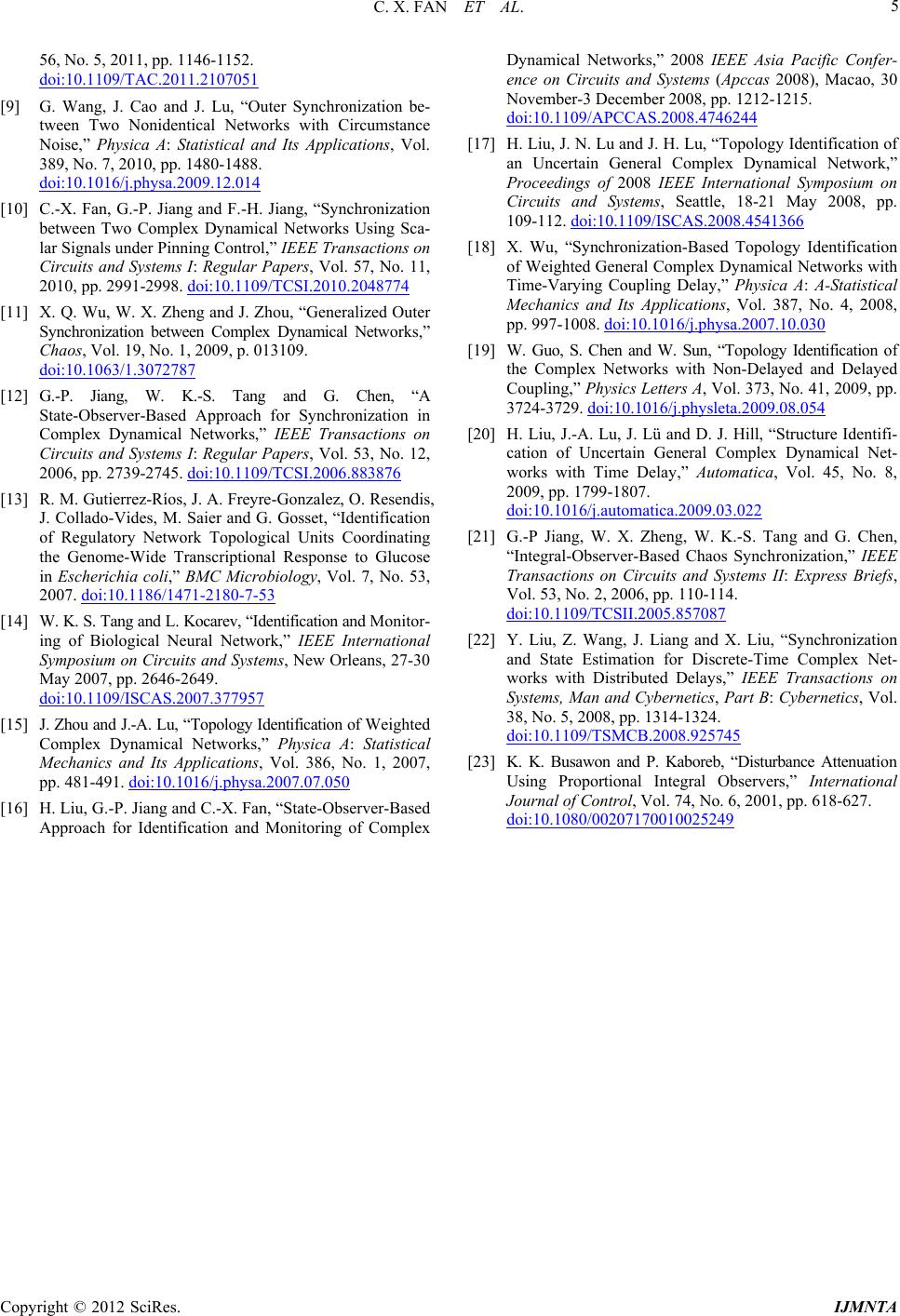 C. X. FAN ET AL. Copyright © 2012 SciRes. IJMNTA 5 56, No. 5, 2011, pp. 1146-1152. doi:10.1109/TAC.2011.2107051 [9] G. Wang, J. Cao and J. Lu, “Outer Synchronization be- tween Two Nonidentical Networks with Circumstance Noise,” Physica A: Statistical and Its Applications, Vol. 389, No. 7, 2010, pp. 1480-1488. doi:10.1016/j.physa.2009.12.014 [10] C.-X. Fan, G.-P. Jiang and F.-H. Jiang, “Synchronization TCSI.2010.2048774 between Two Complex Dynamical Networks Using Sca- lar Signals under Pinning Control,” IEEE Transactions on Circuits and Systems I: Regular Papers, Vol. 57, No. 11, 2010, pp. 2991-2998. doi:10.1109/ [11] X. Q. Wu, W. X. Zheng and J. Zhou, “Generalized Outer Synchronization between Complex Dynamical Networks,” Chaos, Vol. 19, No. 1, 2009, p. 013109. doi:10.1063/1.3072787 [12] G.-P. Jiang, W. K.-S. Tang and G. Chen, “A State-Observer-Based Approach for Synchronization in Complex Dynamical Networks,” IEEE Transactions on Circuits and Systems I: Regular Papers, Vol. 53, No. 12, 2006, pp. 2739-2745. doi:10.1109/TCSI.2006.883876 [13] R. M. Gutierrez-Ríos, J. A. Freyre-Gonzalez, O. Resendis, J. Collado-Vides, M. Saier and G. Gosset, “Identification of Regulatory Network Topological Units Coordinating the Genome-Wide Transcriptional Response to Glucose in Escherichia coli,” BMC Microbiology, Vol. 7, No. 53, 2007. doi:10.1186/1471-2180-7-53 [14] W. K. S. Tang and L. Kocarev, “Identification and Monitor- ing of Biological Neural Network,” IEEE International Symposium on Circuits and Systems, New Orleans, 27-30 May 2007, pp. 2646-2649. doi:10.1109/ISCAS.2007.377957 [15] J. Zhou and J.-A. Lu, “Topology Identification of Weighted Complex Dynamical Networks,” Physica A: Statistical Mechanics and Its Applications, Vol. 386, No. 1, 2007, pp. 481-491. doi:10.1016/j.physa.2007.07.050 [16] H. Liu, G.-P. Jiang and C.-X Approach for Identification and Monitoring of . Fan, “State-Observer-Bas Complex ed Dynamical Networks,” 2008 IEEE Asia Pacific Confer- ence on Circuits and Systems (Apccas 2008), Macao, 30 November-3 December 2008, pp. 1212-1215. doi:10.1109/APCCAS.2008.4746244 [17] H. Liu, J. N. Lu and J. H. Lu, “Topology Ident an Uncertain General Complex Dynam ification of ical Network,” Proceedings of 2008 IEEE International Symposium on Circuits and Systems, Seattle, 18-21 May 2008, pp. 109-112. doi:10.1109/ISCAS.2008.4541366 [18] X. Wu, “Synchronization-Based Topology Identification of Weighted General Complex Dynamical Networks with Time-Varying Coupling Delay,” Physica A: A-Statistical Mechanics and Its Applications, Vol. 387, No. 4, 2008, pp. 997-1008. doi:10.1016/j.physa.2007.10.030 [19] W. Guo, S. Chen and W. Sun, “Topology Identification of the Complex Networks with Non-Delayed and Delayed Coupling,” Physics Letters A, Vol. 373, No. 41, 2009, pp. 3724-3729. doi:10.1016/j.physleta.2009.08.054 [20] H. Liu, J.-A. Lu, J. Lü and D. J. Hill, “Structure Identifi- cation of Uncertain General Complex Dynamical Net- works with Time Delay,” Automatica, Vol. 45, No. 8, 2009, pp. 1799-1807. doi:10.1016/j.automatica.2009.03.022 [21] G.-P Jiang, W. X. Zheng, W. K.-S. Tang and G. “Integral-Observer-Based Chaos Synch Chen, ronization,” IEEE Transactions on Circuits and Systems II: Express Briefs, Vol. 53, No. 2, 2006, pp. 110-114. doi:10.1109/TCSII.2005.857087 [22] Y. Liu, Z. Wang, J. Liang and X. L and State Estimation for Discre iu, “Synchronization te-Time Complex Net- works with Distributed Delays,” IEEE Transactions on Systems, Man and Cybernetics, Part B: Cybernetics, Vol. 38, No. 5, 2008, pp. 1314-1324. doi:10.1109/TSMCB.2008.925745 [23] K. K. Busawon and P. Kaboreb, “D Using Proportional Integral Obse isturbance Attenuation rvers,” International Journal of Control, Vol. 74, No. 6, 2001, pp. 618-627. doi:10.1080/00207170010025249
|